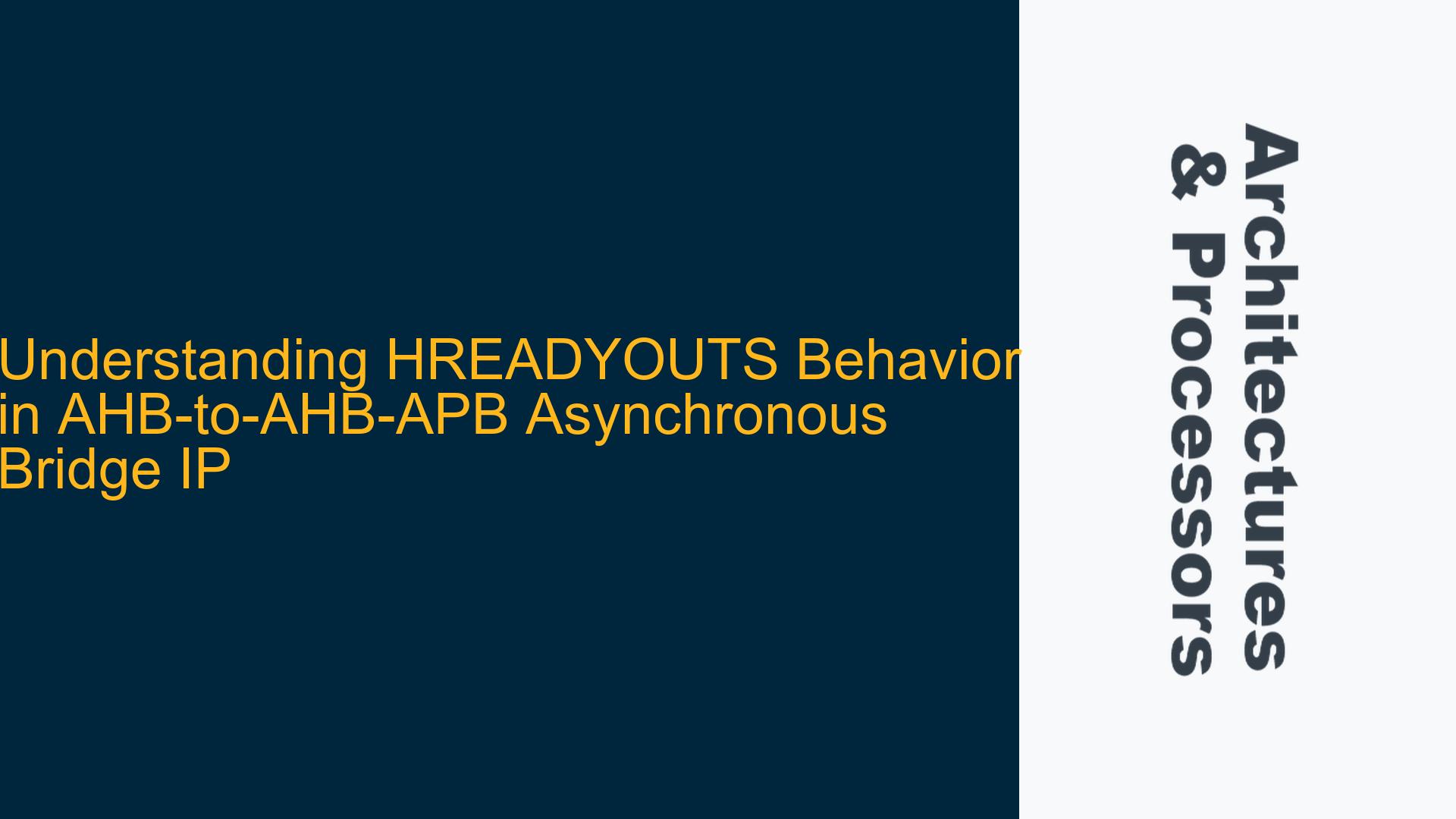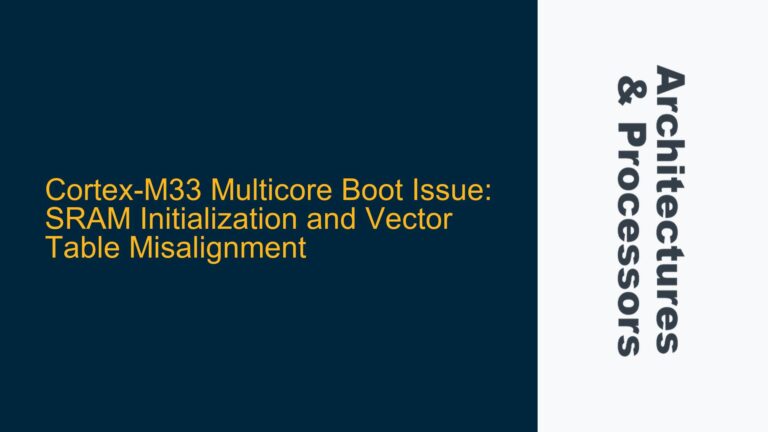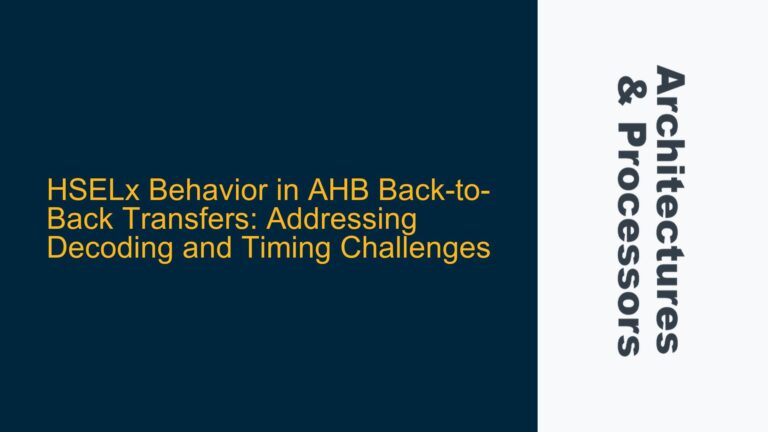HREADYOUTS Signal Behavior During AHB-to-AHB-APB Asynchronous Transfers
The HREADYOUTS signal in the AHB-to-AHB-APB asynchronous bridge IP plays a critical role in ensuring proper synchronization and data transfer between two AHB buses operating in different clock domains. When a transmission starts, the HREADYOUTS signal drops to 0, indicating that the bridge is not ready to accept or complete the transfer. This behavior is consistent with the AMBA specification, but understanding the specifics of how long HREADYOUTS remains low and the factors influencing this duration is essential for system design and debugging.
The HREADYOUTS signal remains low for a variable number of cycles depending on the clock ratio between the two AHB domains. For example, if the source AHB domain operates at 100 MHz and the destination AHB domain operates at 50 MHz, the bridge may require additional cycles to synchronize the data transfer, resulting in HREADYOUTS being low for multiple cycles. This behavior ensures that data integrity is maintained across the asynchronous boundary.
In scenarios where multiple non-sequential (NON_SEQ) transfers occur in sequence, the HREADYOUTS signal will drop to 0 for each transfer, regardless of whether it is the first or subsequent transfer. This means that each transfer incurs the same synchronization overhead, and the bridge does not optimize or pipeline the transfers to reduce the number of wait states. This behavior is consistent across all transfer sizes supported by the bridge, including BYTE, HALFWORD, and WORD transfers.
The clock ratio between the two AHB domains is the primary factor determining the number of cycles HREADYOUTS remains low. For instance, if the source clock is twice as fast as the destination clock, the bridge may require two cycles in the source domain to complete a single cycle in the destination domain. This results in HREADYOUTS being low for two cycles in the source domain. The bridge does not support burst transfers or transfers larger than 32 bits, so the transfer size does not influence the number of wait states.
Clock Domain Synchronization and Transfer Size Limitations
The AHB-to-AHB-APB asynchronous bridge IP is designed to handle transfers between two AHB buses with different clock domains, but it has specific limitations that must be considered during system design. The bridge only supports transfers up to 32 bits in size, and any attempt to perform a transfer larger than 32 bits will be ignored. This limitation is critical when designing systems that require larger data transfers, as additional logic or a different bridge IP may be needed to handle such cases.
The bridge also ignores transfers under specific conditions, such as when the HTRANS signal is IDLE or when the HSEL signal is 0. In these cases, the bridge does not process the transfer, and the HREADYOUTS signal remains high. This behavior is consistent with the AMBA specification and ensures that the bridge does not introduce unnecessary wait states for invalid or idle transfers.
The clock ratio between the two AHB domains is a key factor in determining the number of wait states introduced by the bridge. For example, if the source clock is three times faster than the destination clock, the bridge may require three cycles in the source domain to complete a single cycle in the destination domain. This results in HREADYOUTS being low for three cycles in the source domain. The bridge does not optimize the synchronization process based on the transfer size or type, so the number of wait states remains consistent across all valid transfers.
The bridge’s behavior is deterministic and predictable, but it requires careful consideration of the clock ratios and transfer sizes to ensure optimal performance. Designers must account for the additional latency introduced by the bridge when calculating system timing and performance metrics. This is particularly important in real-time systems where timing constraints are critical.
Implementing Clock Domain Crossing and Debugging HREADYOUTS Issues
When implementing the AHB-to-AHB-APB asynchronous bridge IP, it is essential to follow best practices for clock domain crossing and to thoroughly debug any issues related to the HREADYOUTS signal. The first step is to ensure that the clock ratios between the two AHB domains are correctly configured and that the bridge is operating within its specified limits. This includes verifying that the source and destination clocks are stable and within the acceptable frequency range for the bridge.
Next, designers should carefully analyze the timing of the HREADYOUTS signal to ensure that it aligns with the expected behavior based on the clock ratios and transfer types. This can be done using simulation tools or by capturing and analyzing the signal on a logic analyzer. If the HREADYOUTS signal remains low for longer than expected, it may indicate an issue with the clock synchronization or an unexpected condition in the bridge.
In cases where the HREADYOUTS signal does not behave as expected, designers should first verify that the HTRANS and HSEL signals are correctly configured and that the bridge is not ignoring valid transfers. This includes checking that the HTRANS signal is set to NON_SEQ or SEQ for valid transfers and that the HSEL signal is asserted for the target slave. If these signals are not correctly configured, the bridge will not process the transfer, and the HREADYOUTS signal will remain high.
If the HREADYOUTS signal remains low for an unexpected number of cycles, designers should investigate the clock synchronization logic within the bridge. This includes verifying that the clock ratio is correctly configured and that the bridge is not introducing additional wait states due to timing violations or other issues. In some cases, it may be necessary to adjust the clock ratios or to use a different bridge IP that better meets the system’s requirements.
Finally, designers should thoroughly test the system under various operating conditions to ensure that the HREADYOUTS signal behaves as expected and that the bridge does not introduce any unexpected latency or timing issues. This includes testing with different clock ratios, transfer sizes, and transfer types to verify that the bridge operates correctly in all scenarios. By following these steps, designers can ensure that the AHB-to-AHB-APB asynchronous bridge IP is correctly implemented and that any issues related to the HREADYOUTS signal are quickly identified and resolved.
Conclusion
The HREADYOUTS signal in the AHB-to-AHB-APB asynchronous bridge IP is a critical component of the synchronization process between two AHB buses operating in different clock domains. Understanding its behavior, including the factors that influence the number of wait states and the limitations of the bridge, is essential for designing and debugging systems that use this IP. By carefully analyzing the clock ratios, transfer sizes, and signal timing, designers can ensure that the bridge operates correctly and that any issues related to the HREADYOUTS signal are quickly resolved. This thorough understanding of the bridge’s behavior is key to achieving optimal performance and reliability in systems that require asynchronous AHB-to-AHB communication.






